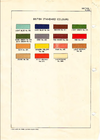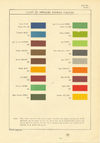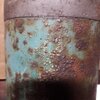Been trying to find some decent markings of the British 3.5inch practice rocket mainly on the actual war head hollow charge section, not the rocket motor. There seems to be two practice colours and marks for the war head in a light blue or a duck egg blue. Usually the markings are in white either marked up in HE SUB or M20 practice showing lot number or TX etc, also black inspection marks in black like GD etc. Anyone have any pictures of decent readable markings on their rocket.
British Ordnance Collectors Network
British M20 Bazooka practice rocket 3.5 inch markings
- Thread starter BMG50
- Start date
Thanks Slick, quite a few variants of practice colours and markings. Looking at the head I have has a green under the paint where it once was a HE round but has been converted HE sub, it still has the cone in it.
Not sure what practice blue was before NATO blue colours took over as the practice rocket motor and fuze in mint condition I have is dated 1/ 1954, not sure if the colour I have is Turquoise blue BS381c 102, anyone know???
Not sure what practice blue was before NATO blue colours took over as the practice rocket motor and fuze in mint condition I have is dated 1/ 1954, not sure if the colour I have is Turquoise blue BS381c 102, anyone know???
Here are three practice 3.5-inch rockets, and beneath is a drill version for comparison. Latter much used and abused, the nose dented by being dropped in its container a number of times.
And a close up of one warhead.
Pam No 9 (1953) gives pics, but these are all in black and white.
As you see, designation is M29, not M20, and the Launcher was never referred to as a "Bazooka" in British service. At least, not whilst I was in!
You will also see that the forward part of the motor assembly is a slightly different shade of blue to the warhead itself, probably because of different factory manufacturers motor/warhead, but Tim will have more info on that.
If I can help further, BMG50, don't hesitate, PM if you prefer.
Alan1.![DSCN0985[1].JPG DSCN0985[1].JPG](https://www.bocn.co.uk/data/attachments/179/179209-a117a5fd64f0a628eddfb371b67d10b7.jpg)
![DSCN0986[1].JPG DSCN0986[1].JPG](https://www.bocn.co.uk/data/attachments/179/179210-13d9b975705f607c9ee880ac4d2da6ec.jpg)
And a close up of one warhead.
Pam No 9 (1953) gives pics, but these are all in black and white.
As you see, designation is M29, not M20, and the Launcher was never referred to as a "Bazooka" in British service. At least, not whilst I was in!
You will also see that the forward part of the motor assembly is a slightly different shade of blue to the warhead itself, probably because of different factory manufacturers motor/warhead, but Tim will have more info on that.
If I can help further, BMG50, don't hesitate, PM if you prefer.
Alan1.
![DSCN0985[1].JPG DSCN0985[1].JPG](https://www.bocn.co.uk/data/attachments/179/179209-a117a5fd64f0a628eddfb371b67d10b7.jpg)
![DSCN0986[1].JPG DSCN0986[1].JPG](https://www.bocn.co.uk/data/attachments/179/179210-13d9b975705f607c9ee880ac4d2da6ec.jpg)
Grateful to Tim for additional information.
But he is, of course, teasing me. He knows perfectly well that the 'fuze' (sic) is in fact the safety band wch retains the spring loaded ejection pin in place and wch is removed as the rocket is loaded into the rear of the launcher. The fiddly bit was esuring that the pin remained in place to be held by the launcher tube itself until the rocket exited the launcher muzzle on firing. If you allowed the pin to ping out whilst loading it was absolute bollox (term frequently used in the Infantry) because the rocket was now armed and had to be carefully removed and kept vertical, nose upward, and destroyed with a demo charge. Unless, of course, you were in action.
The pic shows a couple of safety bands and ejection pins, some bands had instructions on them.
Also the pages of Pam 9 dealing with ammo, for info, apologies for the poor quality of this pic. I am the world's worst photographer.
Alan1.![DSCN0987[1].JPG DSCN0987[1].JPG](https://www.bocn.co.uk/data/attachments/179/179211-7255cb92ba63f043535061597df22baa.jpg)
But he is, of course, teasing me. He knows perfectly well that the 'fuze' (sic) is in fact the safety band wch retains the spring loaded ejection pin in place and wch is removed as the rocket is loaded into the rear of the launcher. The fiddly bit was esuring that the pin remained in place to be held by the launcher tube itself until the rocket exited the launcher muzzle on firing. If you allowed the pin to ping out whilst loading it was absolute bollox (term frequently used in the Infantry) because the rocket was now armed and had to be carefully removed and kept vertical, nose upward, and destroyed with a demo charge. Unless, of course, you were in action.
The pic shows a couple of safety bands and ejection pins, some bands had instructions on them.
Also the pages of Pam 9 dealing with ammo, for info, apologies for the poor quality of this pic. I am the world's worst photographer.
Alan1.
![DSCN0987[1].JPG DSCN0987[1].JPG](https://www.bocn.co.uk/data/attachments/179/179211-7255cb92ba63f043535061597df22baa.jpg)
It seems that there are two types of war head in the sense of construction, one cast with the base blanked off where the fuze screws into the head at the base as part of the casting and fitted with a screw fixed nose cone.
.
The other which i have ls machined steel which looks like its converted from a live HE head to practice as you can still see the green paint under the light blue. The base of this war head is open and is filled with light green wax with a felt washer that tops it that screws up to the top of the fuze section. It seems that these heads types have the copper cone fitted and the nose cone is soldered in place. On the end if this cone is a screw that is soldered over.
Not sure if this light blue one of mine is the early version than the dark blue of Alans and Slick.
The Deep Saxon blue 113 i assume is the dark blue of Alans rockets, what is the light blue of mine, is it sky blue 101 or Artic blue 112.
The cast type are prone to cracking on impact, thanks Alan for you offer of help, much appreciated. Once i find the correct marking on mine i will be laser cutting some rubber stamps for it after its painted, at least i have the Lot number markings on the base.
.
The other which i have ls machined steel which looks like its converted from a live HE head to practice as you can still see the green paint under the light blue. The base of this war head is open and is filled with light green wax with a felt washer that tops it that screws up to the top of the fuze section. It seems that these heads types have the copper cone fitted and the nose cone is soldered in place. On the end if this cone is a screw that is soldered over.
Not sure if this light blue one of mine is the early version than the dark blue of Alans and Slick.
The Deep Saxon blue 113 i assume is the dark blue of Alans rockets, what is the light blue of mine, is it sky blue 101 or Artic blue 112.
The cast type are prone to cracking on impact, thanks Alan for you offer of help, much appreciated. Once i find the correct marking on mine i will be laser cutting some rubber stamps for it after its painted, at least i have the Lot number markings on the base.
@Alan1 - I think we are talking at cross purposes. I'm refering to that part the Safety Band wraps around. On the HE rocket it was L16A1 on the Practice L5 Mark 2. The latter is little more than a housing for the Ejector Pin.
@BMG50 - UK Practice munitions are Deep Saxe Blue, No 113. The name Deep Saxe Blue is misleading, it's not a dark blue. Alan's images are of the same warheads.
TimG
@BMG50 - UK Practice munitions are Deep Saxe Blue, No 113. The name Deep Saxe Blue is misleading, it's not a dark blue. Alan's images are of the same warheads.
TimG
Hi Tim so all practice heads are deep saxe blue 113, so is my projectile head colour faded as i thought it was the same colour as the fuze section ie light blue. I also thought there was another practice blue on mid 1950 rounds before Nato colours came into effect, that why i thought sky blue 101 and artic blue 112 matched the light blue .@Alan1 - I think we are talking at cross purposes. I'm refering to that part the Safety Band wraps around. On the HE rocket it was L16A1 on the Practice L5 Mark 2. The latter is little more than a housing for the Ejector Pin.
@BMG50 - UK Practice munitions are Deep Saxe Blue, No 113. The name Deep Saxe Blue is misleading, it's not a dark blue. Alan's images are of the same warheads.
TimG
Bit confusing with all these different practice blues.
I refurbed one a long time ago, in my post theres a drawing of the practice fuze ..I assume this ejector pin holds the firing pin in place.
Practice 3.5 inch Rocket
A few weeks ago i was given what was left of a British 3.5 inch practice rocket,at first glance it didnt look too bad but other than the obvious lack of fins the warhead had lost a layer of metal where the paint had come off plus had several holes, Fortunately the rocket was easily stripped by...
www.bocn.co.uk
Allan
Hi Alan looking at your restoration page it seems your practice head is the same as mine in the same shade of blue with HE SUB in white lettering plus its the same construction with cone, and waxed filled which leaves me with the question, was there two blues.
Eggburt1969
Well-Known Member
Looking through some old UK documentation on markings, from 1948, 1954, and 1964, the light blue colour used in these documents is stated to be "Turquoise No. 102".
In 1948 and 1954 documents the aforementioned 'Turquoise No. 102' was used for semi-armour piecing (SAP) projectiles with a HE filling. The 1954 document also states that SAP-HE projectiles between 1954-1948 and pre-1945 were of an overall buff colouration.
The 1964 states that "Turquoise No. 102" was now used for practice projectiles.
Referring to far later official documentation from 2006 (DEF STAN 00-810) practice ammunition is now stated to be "Deep Saxe Blue No. 113".
Unfortunately I don't have documentation for between 1964 to 2006, so I don't know when the change in colouration from 'Turquoise No. 102' to 'Deep Saxe Blue No 113' occurred?

Munition paint colours used, as per the 1948 document.

Munition paint colours used, as per the 1964 document
In 1948 and 1954 documents the aforementioned 'Turquoise No. 102' was used for semi-armour piecing (SAP) projectiles with a HE filling. The 1954 document also states that SAP-HE projectiles between 1954-1948 and pre-1945 were of an overall buff colouration.
The 1964 states that "Turquoise No. 102" was now used for practice projectiles.
Referring to far later official documentation from 2006 (DEF STAN 00-810) practice ammunition is now stated to be "Deep Saxe Blue No. 113".
Unfortunately I don't have documentation for between 1964 to 2006, so I don't know when the change in colouration from 'Turquoise No. 102' to 'Deep Saxe Blue No 113' occurred?

Munition paint colours used, as per the 1948 document.

Munition paint colours used, as per the 1964 document
Last edited:
I think the middle one is Dutch.View attachment 203206
Not sure if any of these are British. The middle one is most likely Belgian or Norwegian.
Slick
Well-Known Member
Could be that, for sure.I think the middle one is Dutch.
This turquiose blue i have seen on early munition rockets years ago. Thanks fir that info.Looking through some old UK documentation on markings, from 1948, 1954, and 1964, the light blue colour used in these documents is stated to be "Turquoise No. 102".
In 1948 and 1954 documents the aforementioned 'Turquoise No. 102' was used for semi-armour piecing (SAP) projectiles with a HE filling. The 1954 document also states that SAP-HE projectiles between 1954-1948 and pre-1945 were of an overall buff colouration.
The 1964 states that "Turquoise No. 102" was now used for practice projectiles.
Referring to far later official documentation from 2006 (DEF STAN 00-810) practice ammunition is now stated to be "Deep Saxe Blue No. 113".
Unfortunately I don't have documentation for between 1964 to 2006, so I don't know when the change in colouration from 'Turquoise No. 102' to 'Deep Saxe Blue No 113' occurred?
View attachment 203218
Munition paint colours used, as per the 1948 document.
View attachment 203219
Munition paint colours used, as per the 1964 document
I can't recall ever seeing one. But both the Pam (9, of 1953) and JSP 316, corrected to 1988, show the practice round with HE SUB stencilled beneath the designation markings, so clearly it was fairly common. BMG50 might want to note that the letter height is shown as larger than the designation letters in the Pam but is the same height as the designation letters in the illustration in the JSP. So it is quite likely that variations exist. Life is never easy.
As a parting shot, pun absolutely intended, here is a pic of the copper slug that was supposed to insert itself into the tank hull after the HEAT charge had done its work - I am very carefully phrasing this, Barney please note, - and to whiz around, thus ruining the day of all human occupants.
I picked this up myself after a live firing practice (it was VERY hot).
Alan1.![DSCN0988[1].JPG DSCN0988[1].JPG](https://www.bocn.co.uk/data/attachments/179/179266-bb2339b667b3782d6ddc8576c7e86d5b.jpg)
As a parting shot, pun absolutely intended, here is a pic of the copper slug that was supposed to insert itself into the tank hull after the HEAT charge had done its work - I am very carefully phrasing this, Barney please note, - and to whiz around, thus ruining the day of all human occupants.
I picked this up myself after a live firing practice (it was VERY hot).
Alan1.
![DSCN0988[1].JPG DSCN0988[1].JPG](https://www.bocn.co.uk/data/attachments/179/179266-bb2339b667b3782d6ddc8576c7e86d5b.jpg)



